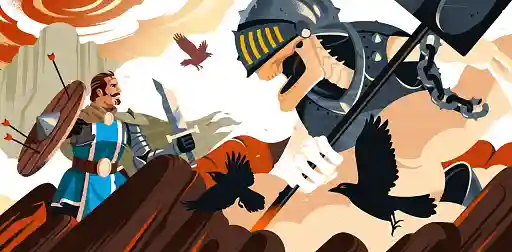Posted on Apr 18, 2024
Man vs Nature: The Most Compelling Conflict in Writing
If you’ve ever been caught in the rain without an umbrella, you’ve experienced one of life’s most timeless conflicts: the clash of man vs nature. Admittedly, this conflict is more compelling from a narrative perspective than when it’s happening to you!
In that vein, this post will dive into what man vs nature means in a story, along with classic examples of this conflict from well-known books, television, and film.
What is man vs nature?
“Man vs nature” is a type of conflict in which a person (or people) must confront something in the natural world — whether that’s the weather, the environment, an animal, or all of the above.
This type of conflict can be short-lived, as in our “caught in the rain” example. However, if something is described as a “man vs nature” story, it typically takes up most of the narrative. Of course, the protagonist is not always aware that they’re “fighting” nature, and may even think nature is on their side… but the truth always comes to light in the end.
What does man vs nature signify?
One of the best things about reading (or writing!) man vs nature is how many thematic forms it can take. In literature or onscreen, this conflict might be used to illustrate:
- The futility of man fighting against nature’s power (as in the film Twister)
- Alternatively, how man is able to grow stronger by facing nature (as in Cheryl Strayed’s memoir Wild)
- The inherent wildness of nature, even when humans attempt to tame/control it (as in Jurassic Park)
- How nature can turn even the most civilized-seeming people into beasts (as in Lord of the Flies)
- That nature is full of mysteries, some of which are best left untouched (as in Annihilation)
A creator’s approach to tackling man vs nature will depend on a few factors: cultural context, previous influential works, and indeed, the creator’s own beliefs. But however they go about it — and whether or not you agree with their message — man vs nature is undeniably a powerful vehicle for storytelling.
Let’s look at some examples of how writers have characterized this type of conflict.
Examples from literature
Moby-Dick by Herman Melville
One of the classic literary examples of man vs nature is Moby-Dick — “a good, simple tale about a man who hates an animal,” in the words of Ron Swanson. But while this is an amusing summary, the central conflict of Moby-Dick is actually quite complex.
Narrated by the sailor Ishmael, Moby-Dick is the story of Captain Ahab and his fanatical obsession with the titular white whale. Having lost a leg to Moby Dick, Ahab vows to kill it in revenge. But the whale continues to evade Ahab and his crew, until at last, Moby Dick takes out the entire ship and drags Ahab away — a harpoon lodged in the whale’s side and its line looped around Ahab’s neck.
🐋 Why it’s compelling: Moby-Dick is a brilliantly ironic tale of “man becoming beast” in his own pursuit of an animal, and how man’s burning ambition can be much more damaging than the chaos of nature. Indeed, if Ahab had only learned humility from his first encounter with Moby Dick, he and the crew would have survived.
Dune by Frank Herbert
Another example of man vs nature — and another epic tale involving huge creatures lurking beneath the surface — is Dune. While the series contains a number of conflicts, one of the first to emerge is Paul Atreides’ struggle to master the desert planet of Arrakis.
Besides the ever-shifting sands and lack of water, Paul must also contend with giant sandworms which tunnel through the dunes and pose a threat to humans — but which are also greatly respected by the native Fremen, and can be used as weapons or even transportation.
🪱 Why it’s compelling: The first layer of this conflict is how, before Paul comes to Arrakis, he believes himself deeply knowledgeable about the planet; yet his studies soon prove shallow in the face of the desert’s harsh reality. It’s only from Chani and the other Fremen that he truly learns what it takes to tame it.
The second layer is how Paul’s eventual mastery of Arrakis still leads him down a path of destruction — something of a reverse Moby-Dick, in the sense that Paul comes to understand the desert too well. It convinces the Fremen that he is their long-prophesied messiah (“he shall know your ways as if born to them”), and incites a galactic Holy War which even Paul is powerless to stop — showing that even “triumph” over nature can still be dangerous.
Examples from film
Cast Away (2000)
Some of the most iconic man vs nature stories take place at sea, and Cast Away is another one worth examining. In this gripping survival drama, Tom Hanks plays Chuck Nolan, a FedEx systems analyst who washes up on a desert island after a plane crash. (Pretty great hook, wouldn’t you say?)
Armed with only a few packages which also survived the crash, Chuck must combat the island’s inhospitable conditions and the psychological toll of being utterly alone. He manages to find food and water, and lives off the island for years before finally constructing a raft to escape — but not without losing his beloved volleyball companion, Wilson, in the process.
🏐 Why it’s compelling: Unlike in many man vs nature stories, Chuck not only survives the perils of nature, but begins mentally recovering from it by the end of the film. This is because he doesn’t abandon his humanity, but rather embraces it — pretending that Wilson is a friend he can talk to, leaving a single unopened FedEx package as a symbol of hope, and so on.
Unlike doomed protagonists like Captain Ahab, Chuck does not fight fire with fire against nature. Rather, he uses logic to survive, while also maintaining hope and an emotional connection to humanity that helps him stay (relatively) sane.
Into the Wild (2007)
Into the Wild is another 2000s survival film (this time a biopic) in which a man must fend for himself against nature, with very few resources or people to rely on. (You’ll find many such films in the “man vs nature” bracket — think 127 Hours, The Martian, etc.)
What sets Into the Wild apart is how Christopher McCandless, aka Alexander Supertramp, chooses to go deep into nature rather than being stranded or forced. He seeks greater meaning through a lifestyle of simplicity: living in an old bus and sustaining himself off the land. Whatever you might think of his methods, this makes his untimely death all the sadder.
🚌 Why it’s compelling: Into the Wild is one of those aforementioned stories where the protagonist believes that nature is their ally, until it turns (often unpredictably) against them. Some have interpreted McCandless’s death as a consequence of his hubris; others as a tragic accident. But whatever its root cause, the takeaway about the natural world is clear — nature does not care whether you live or die.
Examples from television
Yellowjackets
Another particularly unforgiving natural setting — indeed, not so far from where McCandless camped in Alaska — is the Canadian wilderness of Yellowjackets. In this show, a girls’ soccer team crash-lands in Canada on their way to a tournament. Their concerns soon shift from winning the big trophy to surviving the winter.
Yellowjackets has become known for its bold depiction of cannibalism among the girls, as well as other shocking moments of violence and cruelty. And while a few members of the team do survive, it’s clear from the present-day timeline of the show that much of their humanity does not.
🐝 Why it’s compelling: Similar to nature’s role in Lord of the Flies — and with a remarkably similar setup — its role in Yellowjackets is not to change the girls, per se, but to reveal a ferality that was lurking within them all along. While in the wilderness, they blame their behavior on a supernatural force they refer to as “It” — but they know, on some level, that “It” is not real. As the character of Shauna says to the other adult survivors: “You know there’s no It, right? It was just us!”
Survivor
Taking things back to reality for our final example, the long-running reality series Survivor combines the conflicts of “man vs nature” and “man vs man” in equal parts. Its premise is fairly simple: a group of strangers comes to an isolated area to live off the land. They also compete in challenges, seek allies, and vote for who can remain on the show until only one person is left.
Though gameplay has become more complicated over the years due to various twists and turns, the essence of the show remains the same: that one truly deserving player will fight their way to the end and earn the title of Sole Survivor.
🏝️ Why it’s compelling: Survivor has endured largely because it’s not just a man vs nature show, but also mixes in plenty of interpersonal conflict and drama. It’s a reality-based testament to the idea that mastering nature can only get you so far — you also need to “outwit, outplay, outlast” other people in such a competition, as the show’s motto proclaims.
🕵️♀️
Test your theme-detecting skills!
See if you can identify five themes from five questions. Takes 30 seconds!
Of course, if there’s one lesson to take from all of these different examples, it’s that there are countless ways to use “man vs nature” in stories! Whether in fiction or nonfiction, in a Great American Novel or a TV show, the man vs nature conflict will always be exciting, relevant, and thought-provoking.
So look out for it the next time you dive into a novel — or if you’re a writer stuck for ideas, consider putting man vs nature at the heart of things.







